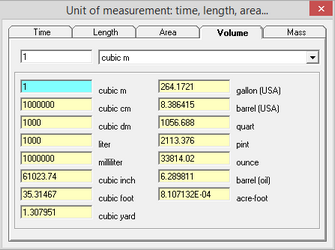
Tab "Volume" of the dialog window "Unit converter (part 2)"
Cubic metre (m3) |
The cubic metre (in Commonwealth English and international spelling) or cubic meter (in American English) is the SI derived unit of volume. |
Litre (l) |
The litre (British and Commonwealth spelling) or liter (American spelling) is a non-SI unit of volume. It is equal to 1 cubic decimetre (dm3), 1,000 cubic centimetres (cm3) or 0.001 cubic metre. A cubic decimetre (or litre) occupies a volume of 10 cm × 10 cm × 10 cm and is thus equal to one-thousandth of a cubic metre. |
Gallon (gal) |
The gallon is a unit of measurement for volume and fluid capacity in both the US customary units and the British imperial systems of measurement. Three significantly different sizes are in current use: the imperial gallon, defined as 4.54609 litres, which is used in the United Kingdom, Canada, and some Caribbean nations; the US gallon defined as 231 cubic inches (exactly 3.785411784 litres), which is used in the US and some Latin American and Caribbean countries; and the US dry gallon, defined as 1⁄8 US bushel (exactly 4.40488377086 litres). There are four quarts in a gallon and eight pints in a gallon, and they have different sizes in different systems. |
Barrel |
A barrel is one of several units of volume applied in various contexts; there are dry barrels, fluid barrels (such as the U.K. beer barrel and U.S. beer barrel), oil barrels and so forth. For historical reasons the volumes of some barrel units are roughly double the volumes of others; volumes in common usage range approximately from 100 to 200 litres (22 to 44 imp gal; 26 to 53 US gal). In many connections the term "drum" is used almost interchangeably with "barrel". |
Quart (qt) |
The quart is an English unit of volume equal to a quarter gallon. It is divided into two pints or (in the US) four cups. Historically, the exact size of the quart has varied with the different values of gallons over time and in reference to different commodities.Presently, three kinds of quarts remain in use: the liquid quart and dry quart of the US customary system and the imperial quart of the British imperial system. All are roughly equal to one liter. 1 quart = 1/4 gallon = 2 pint = 0.946353 л; 1 American dry quart = 1.1012209 l; 1 American liquid quart = 0.9463 l; 1 British imperial quart = 1.1365 l. |
Pint (pint) |
The pint is a unit of volume or capacity in both the imperial and United States customary measurement systems. In both of those systems it is traditionally one eighth of a gallon. The British imperial pint is about 20% larger than the American pint because the two systems are defined differently. Almost all other countries have standardized on the metric system, so the size of what may be called a pint varies depending on local custom. British pint = 1/8 gallon = 0.568261 l; American liquid pint = 1/8 American gallon = 0.473179 l; American dry pint = 1/64 American bushel = 0.550614 l; French pint = 0.931389 l; Dutch pint = 0.6063 l. |
Liquid ounce (oz) |
1 ounce = 29.57 cm3 (USA) or 28.41 cm3 (UK); 1 liquid ounce = 29.5735295625 ml or cm3. |
Barrel (petroleum) |
In the worldwide oil industry, an oil barrel is defined as 42 US gallons, which is about 159 litres, or 35 imperial gallons. |
Acre-foot |
The acre-foot is a non-SI unit of volume commonly used in the United States in reference to large-scale water resources, such as reservoirs, aqueducts, canals, sewer flow capacity, irrigation water, and river flows. An acre-foot equals approximately an 8 lane swimming pool, 25 meters long, 16 m wide and 3 m deep. |